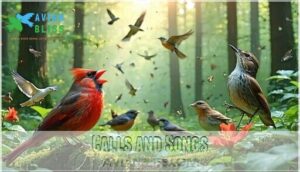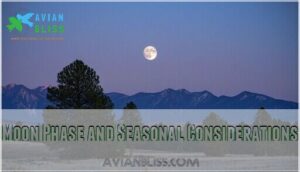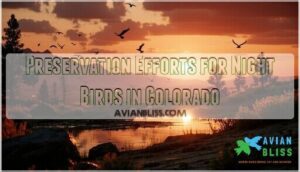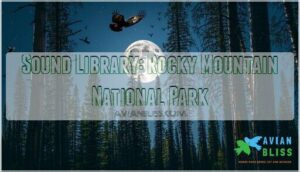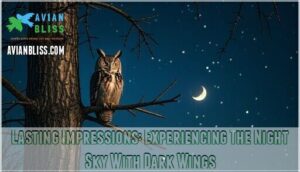This site is supported by our readers. We may earn a commission, at no cost to you, if you purchase through links.

These nocturnal species can be identified by their unique calls, habitats, and behaviors.
As you explore the state’s avifauna, you’ll discover that night birds in Colorado play a vital role in the ecosystem.
From the Great Horned Owl‘s haunting hoot to the Common Nighthawk’s distinctive call, each species has its own story to tell – and you’re about to uncover some fascinating secrets about these mysterious creatures.
Table Of Contents
- Key Takeaways
- Types of Nocturnal Birds in Colorado
- Unique Characteristics and Behaviors of Night Birds
- Identifying Night Birds by Their Sounds
- Importance of Night Birds in Colorado’s Avifauna
- Birdwatching Tips for Spotting Night Birds
- Preservation Efforts for Night Birds in Colorado
- Sound Library: Rocky Mountain National Park
- Lasting Impressions: Experiencing The Night Sky With Dark Wings
- Frequently Asked Questions (FAQs)
- Are there nocturnal birds in Colorado?
- What animals come out at night in Colorado?
- What are nocturnal birds?
- Are night parrots nocturnal birds?
- Are potoos nocturnal birds?
- What does a nightjar bird look like?
- What kind of birds fly around at night?
- What kind of bird makes a call at night?
- Do night birds migrate through Colorado year-round?
- What weather conditions affect nocturnal bird activity?
- Conclusion
Key Takeaways
- You’ll discover 11 species of nocturnal birds in Colorado, including owls, nighthawks, and herons, each with unique characteristics and adaptations that enable them to thrive in the dark.
- To spot these night birds, you’ll want to explore a variety of habitats, such as urban areas, forests, and wetlands, and listen for their distinctive calls and songs that can be heard at night.
- You’ll find that nocturnal birds play a vital role in maintaining ecosystem balance, providing pest control and supporting biodiversity, so it’s essential to appreciate and conserve these species.
- By learning about Colorado’s nocturnal birds, you’ll gain a deeper understanding of their behavior, habitat, and conservation needs, and you can contribute to their protection by supporting habitat preservation and reducing light pollution.
Types of Nocturnal Birds in Colorado
You’ll discover 11 species of nocturnal birds in Colorado, including owls, nightjars, and herons.
As you explore the state’s diverse habitats, you’ll learn about the unique characteristics of each species, such as the Northern Mockingbird and the Great Horned Owl.
Northern Mockingbird
You’ll often hear a Northern Mockingbird’s melodious calls at night.
Key facts about this bird include:
- Mockingbird Songs are common at night
- Nocturnal Feeding occurs in urban habitats
- Melodious Calls attract mates
- Nighttime Behavior is territorial
The Northern Mockingbird is a common night bird in Colorado, exhibiting unique nocturnal feeding habits in urban habitats.
Yellow-breasted Chat
If you’re out at dusk, don’t be surprised if a Yellow-breasted Chat turns up, showing off in thick riverside brush.
This bird skips daytime chatter and belts out its complex song patterns under the stars. Their feather camouflage makes them tricky to spot during the day, but nighttime brings them front and center.
This table highlights their quirky lifestyle:
| Topic | Details |
|---|---|
| Breeding Habits | May–August |
| Nesting Sites | Dense riparian thickets |
| Migration Routes | Colorado to Mexico |
| Calls | Dynamic nocturnal bird calls |
Their unique behavior, including nocturnal activities and distinctive calls, sets them apart from other birds.
Common Nighthawk
You might hear a sharp “peent” and spot white wing-bars as the Common Nighthawk glides through Colorado’s twilight sky.
Relying on silent flight and expert nocturnal hunting, this night bird specializes in catching insects midair—like a bug-catching ninja on wings.
Nighthawk Migration spans thousands of miles, so protecting Nighthawk Habitat is a big win for Bird Conservation.
Next time you’re out Colorado bird watching, look up as day turns to night, and you’ll witness one of nature’s best night bird species in action.
Common Poorwill
Just when you thought the Common Nighthawk was quirky, the Common Poorwill ups the ante among Colorado nocturnal birds.
This fun-sized, cryptic creature is the only known North American bird to hibernate—no joke!
Here’s what sets them apart:
- Masters of torpor behavior during Bird Hibernation.
- Exceptional at Silent Flight while hunting insects.
- Champions of Habitat Conservation and nocturnal migration, supporting healthy night bird species diversity for Colorado bird watching.
Black-crowned Night-Heron
Peering into marshes as the sun dips low, you’ll spot the Black-crowned Night-Heron stalking quietly among reeds.
With a dagger-like bill, this master of night foraging patiently hunts frogs, fish, and insects—perfectly adapted for Colorado nocturnal birds’ Heron Habitat.
Their gravelly “quok” call echoes through the wetlands, hinting at their communal roosts.
You’ll notice amusing rituals—leg stretches and sky-pointing, almost like bird yoga, making them memorable ambassadors for Wetland Conservation and a highlight of any Colorado bird species list, showcasing their unique behaviors.
Great Horned Owl
While the Black-crowned Night-Heron lurks in wetland shadows, the Great Horned Owl is your heavyweight champion of Colorado nocturnal birds.
Short-eared ears and a stare that could outlast a mountain sunrise—these birds of prey rule with catlike grace.
Camp out near the edge of a mature forest, and you’ll spot this top-tier hunter.
- Masters perch-and-pounce hunting tactics
- Keen night vision for tracking unwary prey
- Deep, low hoots that stake territory
- Prefers Owl Habitat near woodland and open fields
- Talons and sharp beak perfect for Owl Behavior
Night vision’s their superpower—think nature’s own night-vision goggles.
Barn Owl
If the Great Horned Owl is the heavyweight, the Barn Owl is the ghost slipping through Colorado’s grasslands.
You’ll know a Barn Owl by its white heart-shaped face and those bone-chilling screeches that echo across fields at midnight.
Their Silent Flight makes spotting them a game of patience. With expert hearing and keen eyes, they rule Barn Owl Habitat, hunting mice with precision.
Wondering how to tell them apart? Here’s a handy table:
| Key Trait | Barn Owl Sound | Nesting Sites |
|---|---|---|
| Feather Camouflage | High-pitched shriek | Barns, tree hollows |
| Silent Flight | Hissing | Haylofts, silos |
| Nocturnal Hunting | Screeches | Old buildings |
Long-eared Owl
Ever wondered what swoops by in Colorado’s wooded thickets after dusk? Meet the Long-eared Owl—a true master of Nocturnal Hunting.
This Rocky Mountain bird wows with:
- Long ear tufts for a signature profile.
- Silent Flight to sneak up on small mammals.
- Night Vision sharp enough for total darkness.
- Feather Camouflage blending into dense branches.
- Low, “hoo-hoo” nocturnal bird calls carrying through the night.
If Owl Habitat and Colorado bird watching are your thing, you’ll love hearing these enchanting night voices in action!
Burrowing Owl
You’re exploring Colorado’s nocturnal birds, and the Burrowing Owl catches your eye.
This owl inhabits abandoned burrows, hunting insects and rodents by day.
Here’s what you might see:
- Grasshoppers scurry as the owl targets them.
- A prairie dog pops up, coaxing young from its burrow.
The owl’s comical antics play out in short grasslands, showcasing its Burrowing Habitat and unique nocturnal hunting style, essential for Owl Conservation in Colorado’s desert ecology.
Short-eared Owl
You’re now observing the Short-eared Owl, a nomadic hunter.
With feather camouflage and wing silence, it excels at night hunting in Colorado’s open fields, impacted by habitat loss.
Its owl migration patterns are irregular, following rodent populations, making it a unique Colorado nocturnal bird species.
Western Screech-Owl
You’re now exploring the Western Screech-Owl, a master of urban adaptation.
- It occupies tree cavities and nest boxes
- Hunts small mammals and insects at night
- Recognizable by its screech calls
The Western Screech-Owl thrives in Colorado’s urban areas, making it a fascinating sight for night birds enthusiasts, showcasing unique nesting habits and nocturnal hunting skills.
The Western Screech-Owl’s ability to adapt to urban habitats is a key factor in its success in Colorado, demonstrating its remarkable ability to thrive in various environments, including those with significant human presence, which is a testament to its urban adaptation.
Unique Characteristics and Behaviors of Night Birds
Nature’s most skilled night hunters possess remarkable nocturnal adaptations that transform darkness into their domain.
Nocturnal birds own the night with exceptional adaptations
These Colorado nocturnal birds have evolved extraordinary night vision through enlarged eyes packed with light-sensitive rod cells, allowing them to navigate moonless environments with precision.
Their specialized feather structure creates silent flight capabilities – soft, fringed wing edges eliminate the whoosh that would alert prey to their approach.
Feather camouflage becomes their daytime armor, with mottled patterns that blend seamlessly into tree bark and shadows.
While most nocturnal birds rely on enhanced hearing to pinpoint rustling mice or insects, some species employ echolocation techniques similar to bats, bouncing sound waves off objects to map their surroundings.
These nocturnal bird behavior patterns include energy-saving torpor during cold nights and strategic hunting from elevated perches.
Night birds switch between strict nocturnal schedules and crepuscular activity depending on prey availability and breeding cycles.
Their heightened auditory senses can detect heartbeats of hidden rodents beneath snow, making them remarkably efficient predators in Colorado’s diverse habitats.
The unique characteristics of night birds, such as their ability to thrive in various nocturnal habitats, contribute to their success as nocturnal hunters.
Identifying Night Birds by Their Sounds
Seven distinct vocal patterns help you identify Colorado’s nocturnal birds through their unique audio signals.
Learning these nocturnal sounds transforms nighttime birdwatching from guesswork into confident identification.
Each species produces distinctive bird calls that cut through darkness like acoustic fingerprints.
The Great Horned Owl’s deep "hoo-hoo-hoo" carries for miles, while Barn Owls screech like rusty hinges.
Common Nighthawks emit sharp "peent" calls before their dramatic diving displays create booming sound waves.
Key nocturnal bird behavior includes:
- Northern Saw-whet Owls deliver repetitive tooting every two seconds
- Western Screech-Owls produce bouncing ball rhythm hoots
- Common Poorwills call "poor-will-low" from rocky perches
- Yellow-breasted Chats warble complex melodies near dense cover
- Black-crowned Night-Herons bark harshly over wetlands
Understanding the nocturnal bird calls is essential for identifying species in their natural habitats.
Download birding apps with audio guides to practice identifying these nocturnal animal sounds.
Start with common species like Great Horned Owls before tackling trickier calls.
Your bird identification guide becomes exponentially more effective once you’ve mastered recognizing these distinctive vocal signatures echoing through Colorado’s night, using unique audio signals and nocturnal sounds to confidently identify birds.
Importance of Night Birds in Colorado’s Avifauna
You play a pivotal role in maintaining ecosystem balance by appreciating Colorado’s nocturnal birds.
Appreciate Colorado’s nocturnal birds to maintain ecosystem balance
As you learn about these birds, remember they provide pest control and biodiversity support. The Great Horned Owl, for example, contributes to conservation value through its ecological roles.
By valuing Colorado nocturnal birds, you support conservation efforts and protect night bird habitats, ensuring the long-term health of our environment. Colorado bird conservation relies on understanding the importance of these species, so let’s give them the recognition they deserve, starting with the fascinating Great Horned Owl.
Many owls rely on specialized feathers for silent flight.
Birdwatching Tips for Spotting Night Birds
You’re about to learn how to spot night birds in Colorado, and it’s easier than you think.
By understanding their habitat, foraging behavior, and distinctive calls, you’ll be well on your way to identifying these elusive creatures.
Habitat and Foraging Behavior
To spot Colorado’s nocturnal birds, you’ll want to explore a variety of habitats.
Here’s a quick guide:
- Urban Habitats: Look for owls in city parks.
- Forest Ecology: Check dense woods for roosting birds.
- Wetland Foraging: Herons and nightjars love these areas.
- Nocturnal Hunting: Open fields are perfect for owls.
Night birds are masters of Terrain Adaptation, blending into their surroundings.
For night bird photography, focus on Colorado wildlife refuge areas. Remember, these birds are part of the diverse Colorado bird species list, so keep an eye out for unique behaviors.
Understanding night bird species is essential for effective birdwatching.
Happy birdwatching!
Calls and Songs
As dusk falls, listen for nocturnal bird species‘ unique vocal patterns.
- Learn to identify the poorwill’s song and Night Herons’ calls to gain insight into their world.
Vocalizations like bird songs and night calls help you discover nocturnal bird species through sound waves and audio clips, making birding easier.
Understanding bird song recording techniques can enhance your ability to identify these nocturnal bird species through sound waves.
Moon Phase and Seasonal Considerations
As you explore nocturnal birds in Colorado, consider lunar cycles and seasonal migration.
| Season | Nocturnal Patterns |
|---|---|
| Spring | Early arrivers call |
| Summer | Nights pulsate with sound |
| Autumn | Migrants on moonlit wings |
| Winter | Hardy owls and early nesters |
Moon phases influence night birds’ behavior, so observe the night sky to understand their seasonal adaptations and nocturnal patterns. Understanding moon phase guides is essential for tracking these birds effectively.
Preservation Efforts for Night Birds in Colorado
You can help preserve Colorado’s nocturnal birds by supporting Habitat Protection and reducing Light Pollution.
Implement Conservation Strategies like planting native vegetation and promoting Eco Friendly Practices.
Get involved in Wildlife Preservation efforts, focusing on bird conservation and protecting nocturnal bird species.
By doing so, you’ll contribute to effective wildlife conservation efforts, ensuring the well-being of Colorado’s unique wildlife, including nocturnal birds.
Sound Library: Rocky Mountain National Park
You’re about to explore the Sound Library: Rocky Mountain National Park, where you’ll discover a wide range of nocturnal bird sounds.
By listening to these recordings, you’ll learn to identify the unique calls and songs of Colorado’s night birds, gaining a deeper appreciation for these fascinating creatures.
You’ll be able to recognize the sounds and develop a better understanding of the nocturnal bird sounds in the area.
Recordings and Research
You’re drawn into the domain of nocturnal birds through audio analysis of bird calls.
- Take acoustic measurements
- Identify species by vocalizations
- Note behaviors synchronized with moon phases
- Quantify responses to changing light
Research methods reveal sound patterns, aiding data collection in wildlife acoustics.
Bird Sound Index
You’re now immersed in the Bird Sound Index.
| Bird Calls | Sound Patterns |
|---|---|
| Great Horned Owl | Low hoots |
| Common Poorwill | Whistled song |
| Common Nighthawk | Nasal peent |
| Barn Owl | Screeching |
| Long-eared Owl | Low hoots |
Nocturnal songs reveal secrets of nocturnal birds through audio recordings.
Natural Soundscapes Index
As night falls, the natural soundscapes of Colorado’s wilderness come alive.
You’ll hear a symphony of nocturnal calls, from crickets’ chirps to owls’ hoots.
- Sound Patterns: Rustling leaves and insect trills create a soothing backdrop.
- Nocturnal Calls: Owls and moths join in, adding to the moonlit chorus.
- Bird Songs: Subtle chirps and trills fill the air, a demonstration of the state’s rich nocturnal ecology.
- Audio Recordings: These natural soundscapes offer a unique way to experience Colorado wildlife, capturing the essence of nocturnal birds and their habitats.
Wildlife Soundscapes Index
Exploring wildlife soundscapes, you discover nocturnal calls, bird songs, and audio recordings.
| Sound Patterns | Nocturnal Calls | Bird Songs |
|---|---|---|
| Chirping | Hooting | Whistling |
| Howling | Screeching | Chattering |
| Croaking | Whimpering | Trilling |
Colorado wildlife reveals its nocturnal ecology through acoustic ecology and nocturnal bird research, disclosing hidden sound patterns.
Soundscapes Throughout The Day
You’ll discover nocturnal sounds are scarce during daytime silence.
Audio recordings reveal distinct sound patterns, particularly bird calls, at night.
Nocturnal bird research and wildlife acoustics focus on these bird vocalizations, providing insight into night birds’ behavior and habitats through careful analysis of recordings, which is crucial for understanding nocturnal sounds.
Soundscapes of The Environment
You’re exploring Environmental Acoustics, where Nocturnal Sounds and Bird Calls converge.
Consider the following aspects:
- Nocturnal animal sounds
- Wildlife soundscape
- Environmental sound conservation
- Bird vocalizations, shaping Sonic Landscapes and nighttime sounds, key to Nighttime Ecology.
Soundscapes of The Weather
You’ll uncover the weather soundscape, featuring storm sounds, wind effects, and climate impact on nocturnal bird sounds.
Revealing how weather patterns influence nighttime sounds and bird vocalizations in environmental sound conservation.
Lasting Impressions: Experiencing The Night Sky With Dark Wings
You’re now experiencing the night sky with dark wings, a world where nocturnal birds thrive.
- Nocturnal Flight patterns reveal unique Wing Adaptations
- Dark Skies enhance Night Vision for Silent Hunters
- Colorado’s diverse landscapes support a wide range of nocturnal birds
- Bird watching at night requires patience and the right gear.
As you gaze up, remember that night birds in Colorado, like the Western Screech-Owl, rely on dark skies to navigate and hunt, making conservation efforts essential for their survival, and for the beauty of their nocturnal flight.
Frequently Asked Questions (FAQs)
Are there nocturnal birds in Colorado?
Yes, Colorado hosts 11 nocturnal bird species including owls, nighthawks, and herons.
You’ll find Great Horned Owls, Barn Owls, Common Nighthawks, and Black-crowned Night-Herons active after dark throughout the state’s diverse habitats.
What animals come out at night in Colorado?
Ever wonder what’s prowling Colorado’s darkness?
You’ll encounter elk, deer, bears, mountain lions, coyotes, raccoons, skunks, porcupines, bats, and various owls like Great Horned and Barn Owls hunting through the night.
What are nocturnal birds?
Nocturnal birds are feathered creatures that you’ll find active during nighttime hours.
They’ve evolved special adaptations like enhanced hearing, silent flight, and keen night vision to thrive in darkness while hunting prey, utilizing their keen night vision.
Are night parrots nocturnal birds?
Night parrots are indeed nocturnal birds, but they’re not found in Colorado.
You’ll find these elusive Australian natives active exclusively at night, using darkness for foraging and avoiding predators in their arid outback habitat.
Are potoos nocturnal birds?
Potoos are strictly nocturnal birds found in Central and South America. You’ll spot them hunting insects at night using their massive mouths and excellent camouflage during daylight hours.
What does a nightjar bird look like?
Like shadows melting into bark, nightjars master camouflage with mottled gray-brown plumage that blends seamlessly into their surroundings.
You’ll spot cryptic patterns of buff, black, and white creating perfect tree-mimicking disguise for these nocturnal hunters.
What kind of birds fly around at night?
You’ll spot owls, nighthawks, and nightjars flying around at night, using adaptations like keen hearing and silent flight to navigate and hunt in the dark.
What kind of bird makes a call at night?
As darkness falls, you’ll hear the Common Poorwill’s haunting "poor-will-low" call, or the Barn Owl’s screeching wails, echoing through the landscape, a symphony of nocturnal bird songs.
Do night birds migrate through Colorado year-round?
You’ll find that some night birds migrate through Colorado year-round, while others visit seasonally, with peak migrations occurring during spring and fall, affecting various species’ presence.
What weather conditions affect nocturnal bird activity?
You’ll notice temperature, moon phase, and precipitation affect nocturnal bird activity, influencing their foraging, breeding, and migration patterns substantially.
Conclusion
As the saying goes, "the night is dark, but full of sound."
You’ll find that exploring night birds in Colorado is a treat, with their unique calls and behaviors.
By learning about these nocturnal species, you’ll gain a deeper appreciation for night birds in Colorado and their essential role in the ecosystem, making your next outdoor adventure even more enjoyable.
- https://www.birdconservancy.org/get-to-know-the-birds-of-the-night/
- https://abcbirds.org/blog20/nighttime-singers/
- https://www.coloradovirtuallibrary.org/resource-sharing/state-pubs-blog/colorados-owl-species/
- https://darkskycolorado.org/category/bird-migration/
- https://coloradosun.com/2021/05/19/lights-out-alerts-bird-migration-colorado/




